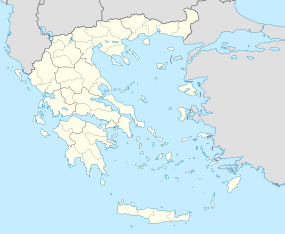Temple of Isthmia
| Location | Kyras Vrysi, Corinthia, Greece |
|---|---|
| Region | Corinthia |
| Coordinates | 37°54′57″N 22°59′35″E / 37.91583°N 22.99306°ECoordinates: 37°54′57″N 22°59′35″E / 37.91583°N 22.99306°E |
| Type | Sanctuary |
| Length | 40.05 m |
| Width | 14.018 m |
| History | |
| Founded | 690 to 650 BC |
| Abandoned | 470 BC |
| Periods | Archaic Greek |
| Satellite of | Isthmia |
The Temple of Isthmia is an ancient Greek temple on the Isthmus of Corinth dedicated to the god Poseidon and built in the Archaic Period. It is about 16 kilometers (9.9 mi) east of ancient Corinth, at the site of ancient Isthmia. It appears to have been constructed in the seventh century BC though was later destroyed in 470 BC and rebuilt as the Temple of Poseidon at Isthmia in c. 440 BC during the Classical period.
The site was originally found by Oscar Broneer in 1952 with excavations continuing until 1967. He published his findings in a series of three volumes starting in 1971, and in articles in the Hesperia Journal. He dated the temple to about 700 BC and produced a reconstruction of the temple which featured a wooden peristyle in the Doric style. Between August 16 and November 29, 1989 a new period of excavation was undertaken, mostly to clear up some of the disputes that had arisen over the conclusions Broneer had made on his finds. The first report of the 1989 findings was published in Hesperia in 1992, with subsequent reports following in later years and has contributed to the debate which primarily focuses around the dating of the temple, but also includes the nature of its layout and general usage and development.
The site of the Temple of Poseidon at Isthmia was one of great activity up until the third century AD. It was the last location of one of the four Pan-Hellenic Games from the sixth century (around 581 BC) to be found, and had numerous buildings constructed in its vicinity. These ranged from Roman baths to a theatre and most importantly two temples. The Archaic temple was the first erected and was destroyed by fire in 470 BC; the site of the temple was then rebuilt upon, resulting in a larger temple constructed directly on top of the Archaic in the Classical period, which was also destroyed by fire, this time in 390 BC. Excavations of the site were conducted in both the original 1952 excavations, and again in 1989. The latter excavations helped to uncover evidence relating to all the areas of development of Isthmia from the Bronze Age to the Roman period, but in particular focused on the Archaic temple, partly because this is the most complete of the buildings found at the site despite being one of the oldest.
...
Wikipedia

